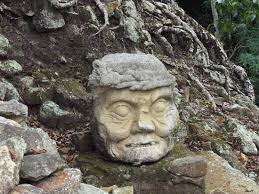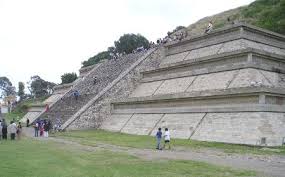The similarities between the Cambodian pyramids at Prasat Thom, Koh Ker
And the Mexican pyramids, this one at La Cañada de la Virgen, Guanajuato...
are striking.
Anyone who has seen pyramids in Mexico cannot fail to note the remarkable similarities. Did the Mexican temples derive from some strange form of Shiva worship?
 |
| Pyramid Temple in Cambodia |
 |
| Pyramid Temple in Tikal Mexico |
The resemblance is uncanny. Was there communication between these ancient peoples?
 |
| Tikal, Mexico |
 |
| Koh Ker, Cambodia |
And what relation if any, exists between the giant carved heads at Bayon,
 |
| Giant Head at Bayon, Cambodia |
And the huge, carved Olmec heads made by the ancient civilizations fo Mexico?
 |
| Olmec Head, Mexico |
 |
| Olmec |
 |
| Cambodian |
Were these mysterious civilizations linked somehow?
 |
| Temple of Shiva at Koh Ker |


Perhaps what is at work here is what's called, "independent parallel development." When people have the same environment, knowledge, and tools, they create similar buildings and styles without ever having been in contact with each other. Both Cambodia and Mexico have tropical forests. The Yucatan peninsula is very similar to the areas around the Tonle Sap lake.
The jungle is similar with similar vines. Bananas, mangos, and coconut palms grow well in both areas. Both places had a powerful heirarchic civilization, well-advanced in social structure. Cambodians knew the use of iron, bronze, silver, and gold. Mayans were not as advanced in terms of technology, but they were close. The Mayans made advanced astronomical calculations of eclipses stretching for thousands of years. Their pyramids were exactly aligned to the cardinal points. The temple at Angkor is off by about 2 degrees. So with the same technical skill sets they set out to build a stairway to heaven, a tower to the stars. The best structural form available for sustaining heavy stones was the pyramid. Perhaps it is no wonder after all. Simply a marvelous set of coincidences.
Here's prominent Professor of Anthropology, Dr. Coe, discussing differences and similarities between ancient Khmer and Mayan civilizations.
Some anthropologists believe in what's called, "cultural diffusion." That is that some communication must have existed between the different civilizations of the past. That this is not impossible was investigated by Thor Heyerdahl in his famous Kon-Tiki expeditions where he sailed by raft across the Pacific to prove a relation between Polynesian groups and South American societies.
Different theories abound. Here's a website on the "Hidden Pyramid Code."
Perhaps we will never know how these parallel structures came to inhabit both sides of the Pacific, so long ago. As a truth-seeker, I'm struck by the idea that perhaps vestiges of the Vedic Civilization and its temples may have penetrated the Americas in a distored form, so long ago. Thanks for checking in.



Yes, vedic civilization had penetrated Mayans, most likely even before they migrated into Americas. Mayan and Vishwakarma are the two recognized and recorded styles of architecture in Vedic civilization. You would know from the Mahabaratha that Krishna had specifically engaged Maya (or Mayans) to build Pandava's palace in Indraprastha. Also, the most authoritative work that is still the basis for the Indian calendar system is the Surya Sidhantham by Maya Danava. So its the Mayans who developed the calender first
ReplyDeleteIt may be interesting to compare genetic information of both, to find out if these parallels in evolution come from a common genetic form. Maya means illusion, in no way is linked to the Mayans. Just an homonym.
ReplyDelete